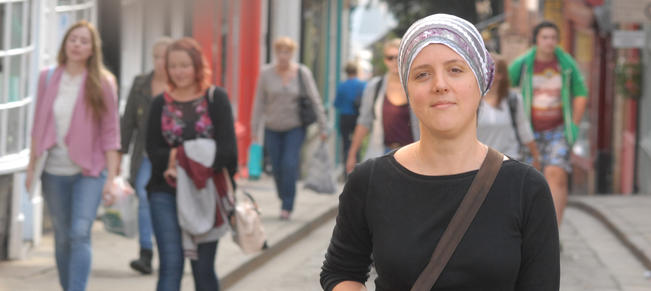Laura Morlock, The Circle
It’s 1914, a war unlike anyone has ever seen is beginning to rage in Europe, and Mennonites in Canada are in a precarious position. The government granted them conscientious objector status when they originally emigrated (the gov’t needed good farmers to “settle” some rich prairie soil), but now that’s being called into question. See, Mennonites are pacifists (you can read more about that here). But as more and more young Canadian men went overseas, more and more Canadian politicians and members of the public demanded to know why Mennonite men were exempt, and who even qualified as a Mennonite.
Enter the ladies.
This coincided with a large number of young women moving into cities to find work. Away from the rural settings, they found the traditional Swiss Mennonite bonnet impractical for factory work, and out of step with their new lives. They still covered their hair with a prayer cap, and there was no discussion of losing the head covering all together (not yet, anyway), but they were replacing the bonnet with simple versions of contemporary hats.
The (majority of the) male leadership was having none of it. Knowing that their community was under close scrutiny, they appealed to the women to maintain Conference dictates and keep the bonnets (proving that they were indeed a community separate and distinct from the larger society, and thereby deserving of their conscientious objector status).
Not surprisingly, the women wanted to know why they had to keep to the dictated dress, but the men did not. Conference standards also called for them to wear the plain coat, but very few did, and the leadership did not pursue it. Their arguments fell on deaf ears, however, and after a series of formal meetings, a council of inquiry, and painful schisms within the church, the Conference held to their earlier standards and demanded women maintain the bonnet. The women were far from being silenced. I found some delightful tidbits in the archives about women standing up in church and publicly tearing a strip off a bishop, or declaring that it was God’s will, not the male leadership’s, that mattered.
This is a chapter in my dissertation, and a paper I am presenting at Eastern Mennonite University’s Crossing the Line: Women of Anabaptist Traditions Encounter Borders and Boundaries conference. Here is the full abstract:
This paper examines how Mennonite groups during World War I used the metaphor of appearance (particularly the prayer bonnet) to express conformity and boundaries while simultaneously pushing boundaries and challenging gendered expectations. These factors helped define a woman’s social location, and became visible markers for the group’s enforcement of membership in the community.
Dress provides distinction between the sacred and the profane, particularly in the symbolic separation of an ethno-religious subculture from the dominant society, often tied to patriarchy and social control of women. While this is a significant part of the head covering debate, the Canadian Mennonites are not simply an interesting example of a common phenomenon wherein men control the powers and privileges of women. In this case, male church leadership sought to regulate women’s appearance in order to gain group-specific benefits (exemption from the draft) for the men. Given the intimate associations between dress and identity, such debates were in a very real sense a battle over women’s bodies for the “greater good” of their faith community. When the women of First Mennonite Church in Kitchener, Ontario, refused to wear regulation bonnets it was a denial of Conference’s final authority. By choosing hats they were showing their autonomy in a setting where they should have been meek and submissive. They demonstrated how women in a deeply patriarchal community can circumvent the apparently rigid system of male authority. Though they were fully aware of the blatantly unfair double standard in dress between men and women, these women were not helpless or willing to submit. While they shared their community’s beliefs in yieldedness, they were confident that their submission was ultimately to God and not male church leadership. Where women are confined within a male dominated culture, control of their own bodies becomes a means by which they can assert their wishes, grievances, and desires. Through these means they can find ways of reworking the very institutions that restrict them. The head covering manifested the religious, social, and gender performance in Ontario in the 1910s and ‘20s.








